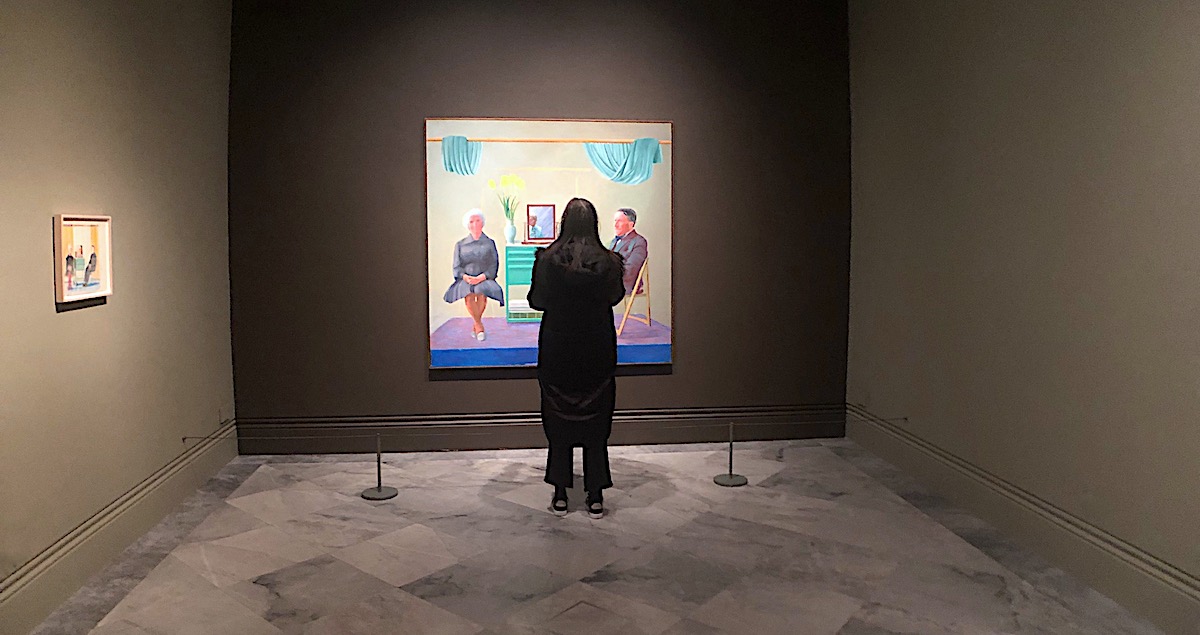As the National Portrait Gallery prepares for its long sleep – three years with its doors firmly shut – it is not surprising to find it playing host to a major show of work by David Hockney. Hockney has made portraits throughout his long career. His exemplars, in this respect, have been Rembrandt, Ingres and Picasso. Like Rembrandt, he has made a great many self-portraits. Like Picasso, when he creates images of people other than himself, he tends to make likenesses, often many times repeated, of people who are close to him. Only rarely does he stray into ‘celebrity’ territory.
A question that arises in this context is whether Hockney is, in fact, a real Modernist – ELS
Celebrities as such are more or less absent from the NG show, though there is one image of Picasso making a likeness of -who else? – David Hockney. Hockney regrets that he never met the Spaniard, though their life-spans overlapped.

Faced with two facts: first that Hockney is now the best known of all living British artists, and second that he is extremely prolific, the organisers of the show, no doubt abetted by the artist himself, have made some sensible decisions. One was to confine it to drawings, with the exception of one large, slightly unfinished double portrait of the artist’s parents which stands sentinel at the entrance to the exhibition but isn’t really part of it. Another thing that is evident is there are very few sitters, all of them people intimately known to the artist: his mother; the textile designer Celia Birtwell; Gregory Evans, once upon a time Hockney’s lover, now his curator and adviser; the master printer Maurice Payne, who has collaborated with Hockney on many of his graphic projects; and a long series of self-portraits of Hockney himself, going back to the mid-1950s. This choice conforms to a contemporary situation, which is that modern portraiture, painted and drawn, really only works well when the artist making them knows his subjects very well. Images of the famous are usually better left to photography. The situation has been evolving for a long time. One sees its beginnings in the long sequence of self-portraits by Rembrandt.
A question that arises in this context is whether Hockney is, in fact, a real Modernist, in connection with the way in which that term is usually employed in connection with art? There is no doubt that he has been experimental in terms of technology. One thinks, for example of the drawings he had made using an iPad. When one looks at occasional works of his that are obviously influenced by Picasso, they seem a little bit me-too, a trifle half-hearted. He doesn’t have Picasso’s urge to tear apart what he has observed and put it back together in an entirely new guise. In no sense is Hockney a Minotaur, dangerous in one way or another to those whom he portrays. He is undoubtedly a very gifted draughtsman, and the images he makes can be, though not always, psychologically penetrating. But his drawings of the figure have, at their best, the polished sweetness of Ingres, to the point where one forgets that he was, at the early height of his career, often classified as a Pop artist. As opposed to being a wonderful drawer of the figure, he doesn’t appear at the NPG as being an inventor of original compositions.
Some of these doubts are, however, mitigated by a new Hockney show that has just opened at his regular London dealer Annely Juda. The catalogue for this does have a celebrity on its cover, none other than the pop star Ed Sheeran, and inside there is a photograph of the two of them, standing on either side of Sheeran’s likeness on an easel. It’s an excellent example of the way in which, in today’s world, one kind of celebrity rubs off on and mutually enhances quite another kind.
The show contains a number of portraits of the kind one would expect, similar to what one sees at the NPG. There are also, however, some massive compositions, with multiple figures, all of whom are on the same small scale, spread out evenly in a huge internal space. These compositions, presented as ‘photographic drawings printed on paper’, are offered in editions of 25 copies. In one, entitled Pictured Gathering with a Mirror, the figures are mostly seated and are reflected in a vast mirror that fills the whole wall behind them. Very few of them, maybe just two or three, seem to relate to one another. The others are visibly solitary. Despite myself, I can’t help reading this as a metaphor for the situation of the celebrity modern artist. He belongs to our world, and at the same time he doesn’t.
Words: Edward Lucie-Smith Photos: P C Robinson © Artlyst 2020

